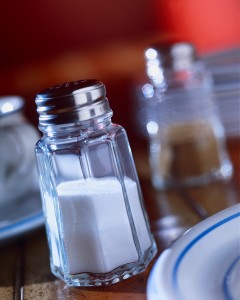The US Dietary Guidelines recommend healthy American adults limit their total sodium to 2,300 mg daily. Individuals with chronic conditions, such as hypertension, diabetes, and chronic kidney disease, should limit intake to 1,500 mg of sodium daily. These limits can be challenging as most American over consume sodium by 1,000 mg daily(PDF).

I frequently receive questions regarding the use of sea salt in place of table salt in an effort to reduce sodium consumption. In truth, both contribute similar amount of sodium per unit. So what is the difference?
Table salt is the most common type of salt found in kitchens across the country. It is made from mined rock salt. The rock salt contains minerals which are removed in the process of refining the salt. Some table salt may have iodine added (this is necessary for proper thyroid function) as well as additives to prevent caking. These additives do not affect the nutritional value of the salt or pose a health risk.
Generally speaking, sea salt is salt that is derived from an ocean or sea. Sea salt may come in many forms, with descriptors such as French or American, fine or course. Sea salt is usually not as refined as table salt since natural harvesting processes like sun and wind evaporation are used. Mineral deposits such as iron, magnesium, calcium, potassium, zinc, and/or iodine remain in the salt imparting different tastes.
Regardless of the type of salt used, sodium can add up quickly. “Hidden” sodium in convenience foods, restaurant foods, and processed food is noted as the primary contributor of sodium(PDF). Reading food labels and limiting salt added at the table can go a long way in reducing overall consumption. For more tips to reduce sodium, visit the National Heart, Lung, and Blood Institute(PDF).

